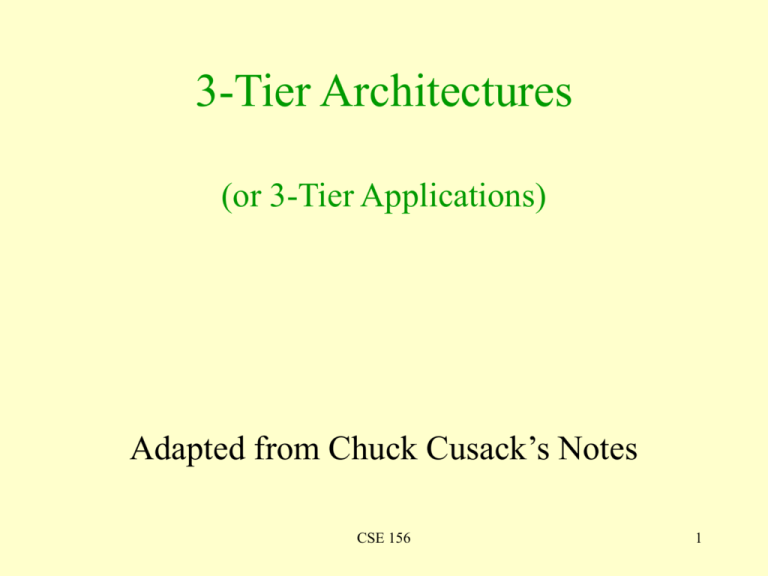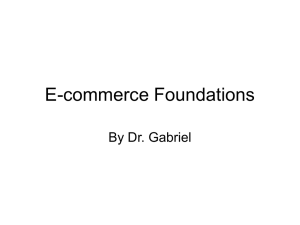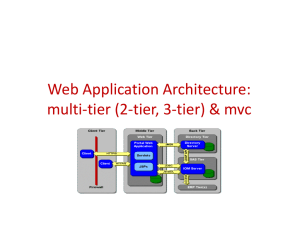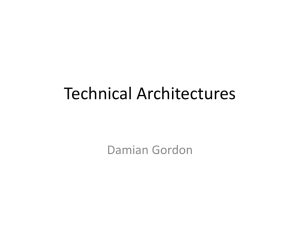Logic: Basic Defintions
advertisement

3-Tier Architectures (or 3-Tier Applications) Adapted from Chuck Cusack’s Notes CSE 156 1 Simple Programs • The programs you have written so far have probably had the following properties: – Input/output was text-based, GUI, and/or with files – Ran locally—that is, they had to be downloaded to the machine on which you (or your T.A.) ran them – The data had to be on the same machine as your program – Were not able to be run simultaneously by more than one person. – Had no interaction with other programs • In the real world, most software is much more complicated than this CSE 156 2 Databases and the Web • Many real applications are different than what you have programmed in two important ways – They make extensive use of databases to store data – They are accessible from anywhere by multiple people simultaneously via the World Wide Web • Sites like amazon.com and ebay.com are entirely database driven—that is, each time you go to the site, what you see is determined by data in their database • As we will see, applications that use databases and are web accessible can be implemented using a 3-tier architectural model CSE 156 3 3-Tier Architectures • Definition: A 3-tier architecture is one which has a client tier, a middle tier, and a database tier. – The database tier manages the database – The middle tier contains most of the logic and communicates between the other tiers – The client tier is the interface between the user and the system • Definition: An n-tier architecture is one which has n tiers, usually including a database tier, a client tier, and n-2 tiers in between. CSE 156 4 Thin-Client 3-Tier Models • The thin-client 3-tier model has these tiers: – The database management system (DBMS) – The main application software – A web browser • Examples – – – – – http://cse.unl.edu/~sscott/teach http://contests.unl.edu http://ebay.com* http://amazon.com* Lotus Notes Web Client* (*These may actually be n-tier) CSE 156 5 Thick-Client 3-Tier Models • The thick-client 3-tier model has these tiers: – The database management system (DBMS) – The main application software – Some sort of interface software which must be installed on each client machine • Examples: – Lotus Notes – Desktop applets that display weather, etc. – RealPlayer and other applications that download CD information from the Web CSE 156 6 Another 3-Tier Model • Another common model has these tiers: – The database management system (DBMS) and a persistence manager which controls all data flow into and out of the database – The main application software – A GUI (thin or thick) • The main difference here is that the main application software is not allowed to interact directly with the database • You could also think of this as a 4-tier architecture: – – – – The database management system (DBMS) A persistence manager The main application software A GUI (thin or thick) CSE 156 7 2- and n-Tier Models • The 2-tier model is more simple, but more limited, than a 3-tier model, and often includes – The database management system (DBMS) – The main application software, including GUI • Here, the entire application is generally run on the client machine (certainly a thick-client) • In some contexts, the 2-tier model is also know as the client-server model, where the server can be something other than a database • In general an n-tier model will have – The database management system (DBMS) – (n-2) application layers – A GUI (thin or thick) CSE 156 8 n-Tier Questions • The following are important questions one must ask when thinking about n-tier architectures – How many tiers should be used? – What tasks should be done by each tier? In other words, how exactly should the layers be divided? – Should I use thin or thick clients? – Should the application be web-accessible? – How should connections to the database be managed? – What database management system (DBMS) should be used? – What languages(s), platform(s), and software should the system use? CSE 156 9 n-Tier Answers • The purpose of these notes is not to – Present clear answers to all of the questions on the previous slide – Be the authoritative source for information about n-tier architectures – Make you an expert in n-tier architectures • Rather, the purpose is to – Introduce you to the concept of n-tier architectures – Get you to start thinking about the issues involved – Give you partial answers to some of the question CSE 156 10 Database Choices • There are many popular database management systems (DBMSs), including – – – – – IBM DB2 Oracle Microsoft SQL Server Microsoft Access MySQL • Which one you should use depends on many factors, including number of expected users, size of the application and/or the database, budget, etc. • Fortunately, the interfaces to these DBMSs have a lot in common, so if you learn to use one, most of what you learn is transferable to the others CSE 156 11 Middle Tier Choices • Almost anything is possible, with some common choices being – Java – Visual Basic – JSP – C# – PHP – .NET – C++ – ASP – Perl • However, whether or not the client will be thin or thick will influence this choice • For a thin client, the obvious middle tier choices are – Java applets, JSP, PHP, ASP, and Perl – Of course with all of these, HTML is involved as well CSE 156 12 Client Choices • Thin clients are generally web browsers, so the important choice was made in the middle tier • For thick clients, we might use – Java applications – C++ applications with GUI provided by • • • • MFC (Microsoft Foundation Classes) Tcl/Tk (Tool command language) GTK (Gimp ToolKit) Qt CSE 156 13 Examples • You could build a 3-tier application which has – Oracle DBMS, C++ middle, and C++/MFC client – MySQL DBMS, PHP middle, and web browser client (http://cse.unl.edu/~sscott/teach uses these choices) – IBM DB2 DBMS, JSP middle, and Java applet client – MySQL DBMS, Java Applet middle, and web browser client – MySQL DBMS, JSP middle, and web browser client (http://contests.unl.edu uses these choices) – Microsoft SQL Server DBMS with ASP access control, ASP middle, and web browser client CSE 156 14 Our Choices • In this class, we will use the following: – – – – Thin-client 3-tier architecture model Database tier: MySQL Middle tier: PHP/HTML and Java applets Client tier: Your favorite web browser • It is important that you realize that – Thin clients are not always the best choice – Three is not always the best number of tiers – Our database and language choices are not the best or only choices, but are reasonable for this class – The approach we take to design and implement 3-tier applications is not the only, and not necessarily the best way CSE 156 15 References • Hugh E. Williams & David Lane, Web Database Applications with PHP and MySQL, 2nd Ed., O’Reilly, 2004 • Stephen McHenry, 3-Tier Architecture– An Introduction, Advanced Software Technologies, Ltd. (http://www.softi.com), 1997 CSE 156 16









